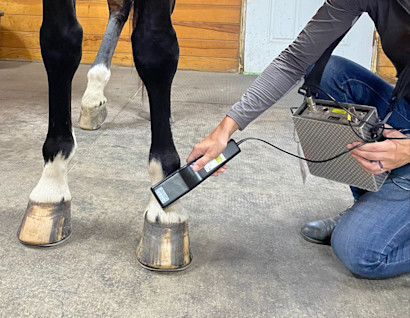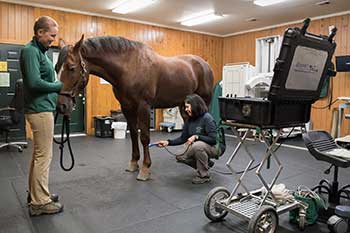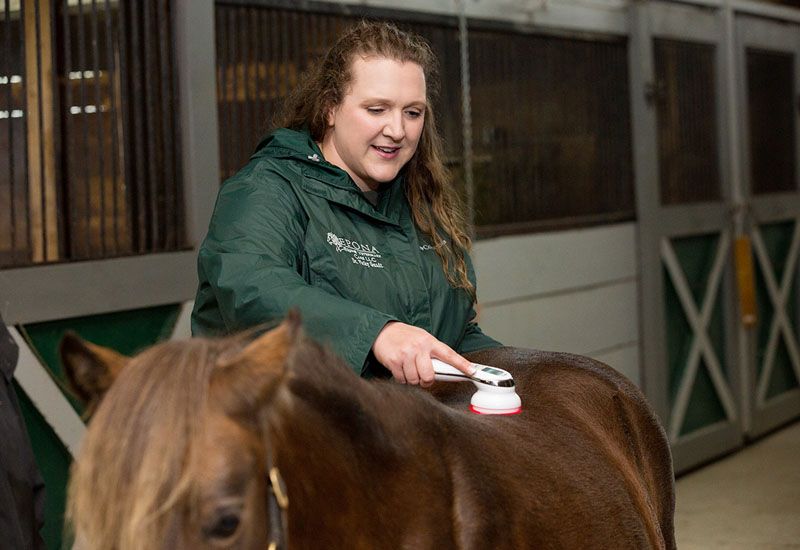The Power of Equine Therapy for Anxiety, PTSD, and Psychological Healing
The Power of Equine Therapy for Anxiety, PTSD, and Psychological Healing
Blog Article
Just How Laser Therapy in Horse Therapy Is Transforming Vet Take Care Of Horses
Laser treatment has become a transformative strategy in equine veterinary care, giving a non-invasive remedy that speeds up healing and improves general health. Leveraging specific light wavelengths, this cutting-edge therapy promotes mobile regrowth, decreases inflammation, and reduces pain. Its efficiency expands from musculoskeletal injuries to persistent ailments like osteoarthritis, dramatically improving wheelchair and life high quality for equines. The portability and versatility of laser treatment tools better highlight their growing indispensability among vets. As we explore the intricate mechanics and real-world successes, the extensive effect on equine clinical techniques comes to be progressively apparent.

Understanding Laser Treatment
Recognizing laser treatment is important for valuing its duty in equine treatment. Laser treatment, likewise called photobiomodulation, entails the application of particular wavelengths of light to cells, which can cause different biological impacts. This therapeutic method harnesses the power of light energy to penetrate the skin and underlying tissues, promoting mobile procedures and improving tissue fixing.
The innovation behind laser therapy is grounded in the concept of photochemistry, where photons are absorbed by chromophores within cells, bring about enhanced ATP production and modulation of reactive oxygen varieties. This, in turn, promotes mobile spreading, decreases inflammation, and speeds up recovery. Veterinary experts use different kinds of lasers, including low-level lasers (LLLT) and high-power Course IV lasers, depending upon the details healing objectives and the nature of the equine condition being dealt with.
Various laser wavelengths and power settings are meticulously selected to target numerous tissue depths and attain wanted professional end results. Safety protocols are critical, as improper usage can result in thermal damage or suboptimal healing effects. Thus, a detailed understanding of laser treatment's mechanisms and applications is critical for its reliable application in equine vet practice.
Benefits for Equine Wellness
The myriad benefits of laser treatment for equine health and wellness include boosted healing, discomfort decrease, and boosted movement. This advanced therapy technique leverages specific wavelengths of light to penetrate cells, stimulating cellular function and promoting fast cells repair service. The non-invasive nature of laser therapy guarantees marginal anxiety and pain for the steed, helping with a smoother healing procedure.

By lowering swelling and discomfort, and boosting tissue repair, laser therapy assists in recovering joint feature and muscle flexibility. Therefore, laser therapy stands as a transformative device in modern-day equine veterinary treatment.
Common Problems Dealt With
Laser treatment has become a functional therapy option for a selection of typical equine problems. Amongst these, musculoskeletal injuries are especially amenable to laser treatment. Soft tissue injuries, such as tendonitis and ligament pressures, gain from the anti-inflammatory and analgesic effects of laser treatments, which speed up healing and decrease pain. In addition, laser therapy is efficient for conditions like osteo arthritis, where it assists reduce joint inflammation and advertise tissue repair service.
Wound administration is an additional area where laser treatment has revealed significant guarantee. Chronic wounds or slow-healing abscess can be particularly tough in horses, yet laser treatment enhances cellular regeneration and enhances blood circulation, therefore expediting the recovery process. Laser treatments have actually been successfully utilized in handling unguis conditions such as laminitis and abscesses, relieving pain and promoting much faster healing.
Equine professional athletes commonly deal with performance-related issues like muscle mass discomfort and tension cracks. Laser treatment aids in decreasing muscular tissue fatigue and expedites the recovery of micro-injuries, therefore making Check This Out sure that equines return to come to a head efficiency quicker. By addressing these varied problems, laser treatment is transforming the landscape of vet treatment, giving a non-invasive, efficient alternative to traditional treatments.
Technology Behind Laser Treatment

Laser gadgets used in veterinary medicine frequently utilize low-level laser treatment (LLLT) or cool laser therapy. Unlike high-powered surgical lasers, these devices operate at lower energy levels, optimizing restorative advantages while reducing thermal damage. The energy from the laser light stimulates adenosine triphosphate (ATP) manufacturing, improves mobile metabolic process, and increases cells repair service processes.
Modern laser treatment tools for equine treatment is created with flexible setups to cater to the details requirements of various tissues and problems. In addition, developments in laser modern technology have led to the advancement of mobile, handheld tools, making it easier for vets to supply therapy in a selection of settings, from facilities to stables.
Success Stories and Study
Showcasing the tangible advantages of laser treatment, numerous success stories and study illuminate its transformative effect on equine health. One such instance involves a purebred racehorse struggling with persistent tendonitis. Conventional treatments produced check over here minimal enhancement, however after incorporating laser treatment into the regimen, the horse showed substantial reductions in swelling and discomfort within weeks, eventually returning to affordable racing.
One more engaging instance features a dressage equine detected with serious pain in the back, limiting its performance. A vet group utilized low-level laser therapy (LLLT) to target the swollen locations, causing significant renovation in flexibility and a noteworthy reduction in discomfort. Over numerous sessions, the equine restored its peak form, showcasing the efficiency of laser therapy in resolving bone and joint problems.
Furthermore, a research carried out at a leading equine facility taken a look at 50 steeds with different soft cells injuries treated with laser therapy. The outcomes stood out: 85% of the steeds showed sped up recovery times and improved flexibility. These situations emphasize the flexibility and performance pop over here of laser treatment in equine medication, offering a non-invasive, scientifically-backed strategy to enhancing recuperation and efficiency in horses.
Conclusion
Laser therapy is reinventing equine veterinary care by offering a non-invasive therapy that speeds up recovery, decreases swelling, and relieves discomfort. With its efficiency in treating a variety of problems, from bone and joint injuries to persistent ailments like osteoarthritis, this technology substantially boosts equine health and wellness and mobility. The portability and adaptability of laser treatment further underscore its transformative effect on veterinary methods, solidifying its duty as a crucial tool in modern equine health care.
Report this page